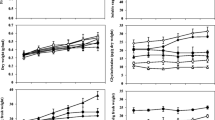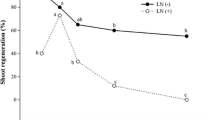Abstract
High temperature strongly hampers the plant growth particularly at early growth stages. In this study, changes in some physiological and anatomical characteristics and possibility of mitigating the adversities of heat stress by soaking sugarcane nodal buds in 20 mM proline and glycinebetaine (GB) solutions have been explored. Heat stress reduced the rate of bud sprouting nonetheless soaking the setts in proline followed by GB was beneficial. In addition, heat stress reduced the bud fresh and dry weights, generated H2O2, reduced the tissue levels of K+ and Ca2+, while increased the osmolytes synthesis in a time course manner. Heat stress also delayed the emergence and expansion of new bud leaves, by restricting the number and area of mesophyll cells. It also caused poor and aberrant development and diffused appearance of mesophyll cells and vascular bundles in the bud leaves. However, soaking of buds in proline and GB solutions substantially reduced the H2O2 production, improved the accumulation of soluble sugars and protected the developing tissues from heat stress effects; although proline was more effective than GB. Correlations of various attributes indicated that soaking in GB and proline restricted the H2O2 generation, improved K+ and Ca2+ contents, and increased the concentrations of free proline, GB and soluble sugars eventually improving the heat tolerance of buds. Cost-benefit analysis showed that, considering increase in sprouting of buds, soaking in 20 mM solution of both osmoprotectants is economical.




Similar content being viewed by others
References
Alexander AG (1973) Sugarcane physiology: a comprehensive study of the saccharum source-to-sink system. Elsevier Scientific Publication, Amsterdam
Al-Ghamdi AA (2009) Evaluation of oxidative stress tolerance in two wheat (Triticum aestivum) cultivars in response to drought. Int J Agric Biol 11:7–12
Ashraf M, Foolad MR (2007) Roles of glycine betaine and proline in improving plant abiotic stress resistance. Environ Exp Bot 59:206–216
Bates IS, Waldren RP, Teare ID (1973) Rapid determination of free proline for water stress studies. Plant Soil 39:205–207
Bohnert HJ, Jensen RG (1996) Metabolic engineering for increased salt tolerance. The next step. Aust J Plant Physiol 23:661–667
Bohnert HJ, Sheveleva E (1998) Plant stress adaptations, making metabolism move. Curr Opin Plant Biol 1:267–274
Ebrahim MKH, Zingsheim O, El-Shourbagy MN, Moore PH, Komor E (1998) Growth and sugar storage in sugarcane grown at temperature below and above optimum. J Plant Physiol 153:593–602
Egli DB, TeKrony DM, Heitholt JJ, Rupe J (2005) Air temperature during seed filling and soybean seed germination and vigor. Crop Sci 45:1329–1335
Farooq M, Basra SMA, Wahid A, Cheema ZA, Cheema MA, Khaliq A (2008) Physiological role of exogenously applied glycinebetaine in improving drought tolerance of fine grain aromatic rice (Oryza sativa L.). J Agron Crop Sci 194:325–333
Farooq M, Aziz T, Wahid A, Lee DJ, Siddique KHM (2009) Chilling tolerance in maize: agronomic and physiological approaches. Crop Past Sci 60:501–516
Gong M, Li YJ, Chen SZ (1998) Abscisic acid induced thermo tolerance in maize seedlings is mediated by Ca2+ and associated with antioxidant systems. J Plant Physiol 153:488–496
Grass I, Burris I (1995) Effect of heat stress during seed development and maturation on wheat (Triticum durum) seed quality. I. Seed germination and seedling vigor. Can J Plant Sci 75:821–829
Grieve CM, Grattan SR (1983) Rapid assay for the determination of water soluble quaternary ammonium compounds. Plant Soil 70:303–307
Gür A, Demirel U, Özden M, Kahraman A, Çopur O (2010) Diurnal gradual heat stress affects antioxidant enzymes, proline accumulation and some physiological components in cotton (Gossypium hirsutum L.). Afr J Biotechnol 9:1008–1015
Hall AE (1992) Breeding for heat tolerance. Plant Breed Rev 10:129–168
Jain R, Shrivastava AK, Solomon S, Yadav RL (2007) Low temperature stress-induced biochemical changes affect stubble bud sprouting in sugarcane (Saccharum spp. hybrid). Plant Growth Regul 53:17–23
Jain R, Solomon S, Shrivastava AK, Lal P (2009) Nutrient application improves stubble bud sprouting under low temperature conditions in sugarcane. Sug Tech 11:83–85
Mahmood S, Wahid A, Javed F, Basra SMA (2010) Heat stress effects on forage quality characteristics of maize (Zea mays) cultivars. Int J Agric Biol 12:701–706
Moore PH (1987) Breeding for stress resistance. In: Heinz DJ (ed) Development in crop science. II. Sugarcane improvement through breeding. Elsevier Science Publishers, Amsterdam, pp 503–542
Morison JIL (1996) Global environment change impacts on crop growth and production in Europe. Implications of global environmental change for crops in Europe. Aspects Appl Biol 45:62–74
Porter JR (2005) Rising temperatures are likely to reduce crop yields. Nature 436:174
Rasheed R, Wahid A, Ashraf M, Basra SMA (2010) Role of proline and glycinebetaine in improving chilling stress tolerance in sugarcane buds at sprouting. Int J Agric Biol 12:1–8
Robertson MJ, Bonnett GD, Hughes RM, Muchow RC, Campbell JA (1998) Temperature and leaf area expansion of sugarcane: integration of controlled-environment, field and model studies. Aust J Plant Physiol 25:819–828
Ruzin SE (1999) Plant microtechnique and microscopy. Oxford University Press, New York
Sakamoto A, Murata N (2002) The role of glycine betaine in the protection of plants from stress: clues from transgenic plants. Plant Cell Environ 25:163–171
Savicka M, Škute N (2010) Effects of high temperature on malondialdehyde content, superoxide production and growth changes in wheat seedlings (Triticum aestivum L.). Ekologija 56:26–33
Sharma P, Sharma N, Deswal R (2005) The molecular biology of the low-temperature response in plants. BioEssays 27:1048–1059
Smirnoff N (2005) Antioxidants and reactive oxygen species in plants. Blackwell Publishing, Oxford
Song SQ, Lei YB, Tian XR (2005) Proline metabolism and cross-tolerance to salinity and heat stress in germinating wheat seeds. Russ J Plant Physiol 52:793–800
Steel RGD, Torrie JH, Dickey DA (1996) Principles and procedures of statistics: a biometrical approach, 3rd edn. McGraw Hill Co, New York
Tendon HLS (1993) Methods of analysis of soil plants water and fertilizers. Fertilization Development and Consultation Organisation, New Delhi
Tiroli-Cepeda AO, Ramos CHI (2010) Heat causes oligomeric disassembly and increases the chaperone activity of small heat shock proteins from sugarcane. Plant Physiol Biochem 48:108–116
Ulukan H (2011) Responses of cultivated plants and some preventive measures against climate change. Int J Agric Biol 13:292–296
Velikova V, Yordanov I, Edreva A (2000) Oxidative stress and some antioxidant systems in acid rain treated bean plants. Protective role of exogenous polyamines. Plant Sci 151:59–66
Verbruggen N, Hermans C (2008) Proline accumulation in plants: a review. Amino Acids 35:753–759
Vollenweider P, Günthardt-Goerg MS (2005) Diagnosis of abiotic and biotic stress factors using the visible symptoms in foliage. Environ Pollut 137:455–465
Wahid A (2007) Physiological implications of metabolites biosynthesis in net assimilation and heat stress tolerance of sugarcane (Saccharum officinarum) sprouts. J Plant Res 120:219–228
Wahid A, Close TJ (2007) Expression of dehydrins under heat stress and their relationship with water relations of sugarcane leaves. Biol Plant 51:104–109
Wahid A, Shabbir A (2005) Induction of heat stress tolerance in barley seedlings by pre-sowing seed treatment with glycinebetaine. Plant Growth Regul 46:133–141
Wahid A, Gelani S, Ashraf M, Foolad MR (2007) Heat tolerance in plants: an overview. Environ Exp Bot 61:199–223
Wahid A, Sehar S, Perveen M, Gelani S, Basra SMA, Farooq M (2008) Seed pretreatment with hydrogen peroxide improves heat tolerance in maize at germination and seedling growth stages. Seed Sci Technol 36:633–645
Wahid A, Sabir H, Farooq M, Ghazanfar A, Rasheed R (2009) Role of nodal bud and sprout tissue nutrients in sprout establishment, growth and salt tolerance of sugarcane. Crop Past Sci 60:453–462
Wahid A, Farooq M, Rasheed R, Gelani S, Rasul E (2010) Sugarcane under thermal stress: some biotechnological considerations. In: Kumar Ashwani (ed) Plant genetic transformation and molecular markers. Pointer Publishers, Jaipur, pp 109–123
Yoshida S, Forno DA, Cock JH, Gomez KA (1976) Laboratory Manual for Physiological Studies of Rice. Los Banos, Philippines
Yousfi N, Slama I, Ghnaya T, Savouré A, Abdelly C (2010) Effects of water deficit stress on growth, water relations and osmolyte accumulation in Medicago truncatula and M. laciniata populations. Comp Rend Biol 333:205–213
Acknowledgments
The financial support of Higher Education Commission (HEC), Islamabad, Pakistan under Indigenous Ph.D. Fellowship Program (5000 Fellowships) Batch-II to first author is acclaimed. Supply of sugarcane material by SRI, Faisalabad, Pakistan and microtomy and photography facilities by Prof. Ahrar Khan and Prof. Zargham Khan, Department of Pathology, University of Agriculture, Faisalabad, Pakistan are duly acknowledged.
Author information
Authors and Affiliations
Corresponding author
Rights and permissions
About this article
Cite this article
Rasheed, R., Wahid, A., Farooq, M. et al. Role of proline and glycinebetaine pretreatments in improving heat tolerance of sprouting sugarcane (Saccharum sp.) buds. Plant Growth Regul 65, 35–45 (2011). https://doi.org/10.1007/s10725-011-9572-3
Received:
Accepted:
Published:
Issue Date:
DOI: https://doi.org/10.1007/s10725-011-9572-3




